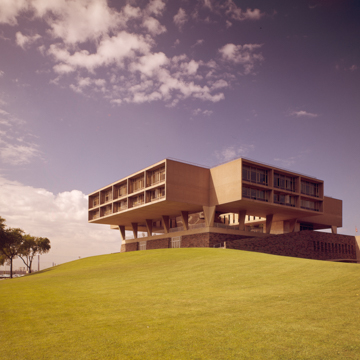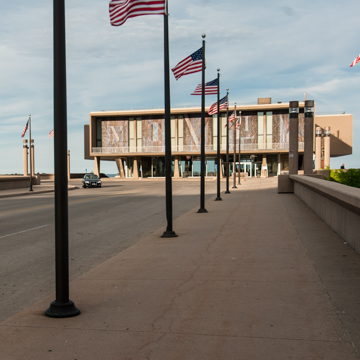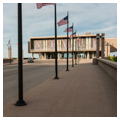Massed above the Lake Michigan shoreline on a stone and concrete base, the Milwaukee County War Memorial is a striking example of modern architecture ideally suited to its site. Designed by Eero Saarinen, a leading American architect of the mid-twentieth century, the cast-concrete structure above a stone base is composed of a large cruciform block with four dramatic cantilevered wings supported by wedge-shaped piers. Saarinen later employed a variation of the War Memorial’s wedge-shaped concrete piers in his spectacular terminal at Washington-Dulles International Airport (1958–1962). Ornamenting the recessed wing above the entrance level, a large five-panel mosaic of Roman numerals commemorates the dates of America’s involvement in World War II and the Korean War. Designed by Milwaukee artist Edmund Lewandowski, the 1.4-million-piece composition of marble and glass is one of the city’s most important examples of modern outdoor art. The memorial quality is emphasized by the names of war dead on granite blocks surrounding a pool in the central courtyard.
The War Memorial, designed as a multi-purpose structure, became the home of the Milwaukee Art Museum in 1957 but still serves as a public meeting facility. To accommodate the museum’s growing needs, a large addition designed by Kahler, compatible with the original structure, was constructed on its east face in 1975. This includes a glass-walled lobby whose transparent public space on the first floor provides a view to Lake Michigan.
In 2001–2002, Calatrava designed the building’s extraordinary lakefront addition, the Spanish architect’s first major commission in the United States. Its most remarkable feature, the Quadracci Pavilion, resembles the rope-rigged prow of a Great Lakes schooner. Nine cables extending from a 198-foot mast, leaning back toward the “stern,” suspend a pedestrian bridge, which spans Lincoln Memorial Drive and connects the museum to downtown Milwaukee. Graceful arches form the roof of curved exhibition spaces paralleling the lake’s edge. The most dramatic element, atop the schooner’s stern, is the sunscreen, which appears to be an enormous white bird taking flight. Biomorphic designs that draw on flowers, birds, skeletons, and other natural forms are a signature of Calatrava’s work. Indeed, this sunscreen moves. Steel fins, connected to a steel spine, open and close like wings to regulate heat and light in the glass reception hall. Designed to shade this ninety-foot-tall reception hall, the sunscreen underwent many changes between design and construction. Calatrava originally designed the wings to be made from a carbon-composite material, but engineers failed to meld carbon fiber to the steel rotating spine that opens and closes the fins. Engineers used a wind tunnel to design a hollow fin with three-millimeter-thick steel sheathing to replace the carbon-fiber original. To accommodate the additional stress and weight of the steel fin sunshade, engineers reinforced the foundation, decking, and backstay beam.
Building an expressive concrete sculpture on the lakefront posed several engineering problems, solved first by building a steel plate cofferdam to restrain the lake during construction. The structure rests on a two-foot-thick reinforced-concrete slab, waterproofed by a bentonite clay membrane. A central beam—the ship’s keel—anchors the structure to the lakeshore.
Even the garage is spectacular. At one end, drivers enter through a small ship’s prow, with walls scored deeply as “speed lines” and a metal railing on top, suggesting a schooner’s deck. Inside, the ribbed vault forms sleek sculptural arches that echo the lines of the automobiles. The roof swoops up at the outer edge to reveal a clerestory.
Landscape architect Dan Kiley of Vermont flanked the addition with a geometric pattern of lawns that are defined by hedges and water channels and dotted with honey locust, crab apple, and linden trees. On concrete plazas water spouts from monumental fountains.







